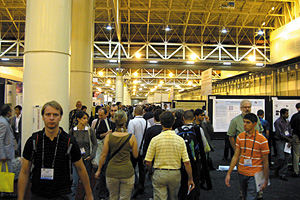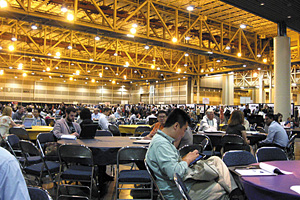For any health care professional devoted to functional neurology – as is the case for chiropractors, whose founding father expressed the importance of tone,1 and for applied kinesiologists, whose focus upon the aberrant manual muscle test ultimately reflects neural dysafferentation2-3 – the significance of the Society for Neuroscience (SfN) cannot be overstated.
Some 45 years ago, neuroscience as a field did not even exist. Now it has actually become the most subscribed science major at several colleges and universities. The SfN itself, founded in 1969, posted 1,396 attendees at its first annual conference in Washington, D.C., in 1971. By 1985, its membership had jumped to 10,000; by 1991, 15,000; by 2002, 30,000; and by 2009, its membership rolls had soared to 40,000. At its 35th Annual Meeting in 2005, its attendance of 34,815 set an all-time record as the largest scientific professional meeting worldwide.
And no wonder. The list of areas that the SfN embraces include some 700 topics and subtopics. To give some overall impression of what these include, I can enumerate eight overarching themes: (1) development; (2) neural excitability, synapses, and glia; cellular mechanisms; (3) disorders of the nervous system; (4) sensory and motor systems; (5) integrative systems: neuroendocrinology, neuroimmunology, and homeostatic challenge; (6) cognition and behavior; (7) novel methods and technology development; and (8) history, teaching, public awareness, and societal impacts in neuroscience.
 Attendees at one of the Society for Neuroscience Annual Conference's eight poster sessions.
Indeed, the leadership of this organization has clearly stated that its growth and survival depend upon people from multiple professions in research offering fresh perspectives. Obviously, this opens a huge door of opportunity for innovative, nontraditional research to be presented before a massive audience. Chiropractic and applied kinesiology communities – are you listening?
Attendees at one of the Society for Neuroscience Annual Conference's eight poster sessions.
Indeed, the leadership of this organization has clearly stated that its growth and survival depend upon people from multiple professions in research offering fresh perspectives. Obviously, this opens a huge door of opportunity for innovative, nontraditional research to be presented before a massive audience. Chiropractic and applied kinesiology communities – are you listening?
Thus, it was with little difficulty that I found an area in which I figured a recent reliability and validity study in therapy localization with Gerry Leisman4 would be received with open arms by the SfN for presentation at its annual conference. The subtopic into which our research fit was "motor neurons and muscle," with the subdivision "motoneuron-muscle interface."
As it turns out, poster presentations are regarded by SfN's leadership as the sine qua non [indispensable element] of its annual meeting. This year, there were 15,000 of them displayed over acres of convention floor space over a four-day period, with ample opportunity for authors to review their findings, field questions, and form connections with the conference's attendees, who impressed me as having massive credentials in research, ranging from program directors to postdoctoral researchers.
The convention itself, held in the Ernest J. Morial Convention Center, which spans some seven city blocks, offered 17,000 presentations and 500 exhibits from vendors overall, including special lectures in each of the eight themes cited above, 23 symposia, 22 minisymposia, 109 nanosymposia (each bundling 8-30 presentations), and 37 workshops/meetings to the 28,411 in attendance. Needless to say, the amount of material presented at this conference was overwhelming and required eight program books to simply list the titles, speakers, vendors, authors, and locations.
 Approximately 1/10th of the poster and table area at this year's conference.
To give an idea of the company one keeps at this conference, my poster was sandwiched between presentations from the Johns Hopkins Medical Center and the University of Florida. Their titles were, respectively, "Regenerating Motor Axons Signal Muscle Contact to Proximal Schwann Cells and Induce Progressive Maturation" and "Practice-Induced Improvements in Movement Control Are Associated With a Reduction of Multi-Motor Unit Discharge Rate Variability." As far as specialization was concerned, elsewhere one could find 386 posters on Parkinson's disease (with 56 devoted to animal intoxication models in Parkinson's disease alone), together with three minisymposia. Epilepsy and Alzheimer's disease had even greater numbers of presentations.
Approximately 1/10th of the poster and table area at this year's conference.
To give an idea of the company one keeps at this conference, my poster was sandwiched between presentations from the Johns Hopkins Medical Center and the University of Florida. Their titles were, respectively, "Regenerating Motor Axons Signal Muscle Contact to Proximal Schwann Cells and Induce Progressive Maturation" and "Practice-Induced Improvements in Movement Control Are Associated With a Reduction of Multi-Motor Unit Discharge Rate Variability." As far as specialization was concerned, elsewhere one could find 386 posters on Parkinson's disease (with 56 devoted to animal intoxication models in Parkinson's disease alone), together with three minisymposia. Epilepsy and Alzheimer's disease had even greater numbers of presentations.
Visitors to my poster included a broad range of researchers from domestic and foreign soil. While their initial attitudes ranged from enthusiastic to curious to skeptical, the finalsentiment that all expressed, without exception, was that this was the first study of its kind in an alternative therapeutic area that presented a plausible and sound scientific basis, such that both further research and clinical practice were strongly justified.
One visitor from the United Kingdom, in particular, described how the lack of a traditional scientific basis in applied kinesiology has led many Brits to look upon it with a jaundiced eye. She welcomed both my results and the paper that I recently published drawing distinctions in the types of AK described in the literature, and reviewing the strengths and weaknesses of the AK as practiced by diplomates; together with weaknesses in derivative procedures which have drawn the bulk of the criticisms.5
Other viewers were pleased at our blinding of the multiple examiners from each other's results and the randomization of their order for treating the patient, together with the indication that the forces applied in this investigation were consistent and equal throughout. Attendees also understood that the examiners could not be blinded from the patient in a typical clinical encounter, but also welcomed the fact that I'd designed a blinded trial protocol waiting to be implemented in another investigation.
Finally, the pertinent question was raised whether women as examiners would be expected to exert the same magnitude of force recorded in the current trial among our three examiners – and my suspicion is that this question is well-founded. This remains an area that needs to be investigated.
The larger picture that emerged from my presentation was that it took its place among a sea of basic researchers, thus raising the credibility of an area of chiropractic before a massive audience – and raising the likelihood of being competitive for federal funding. At the same time, it coincided with the emerging interest of the entire SfN in redirecting its acceptance and public awareness of more clinical studies, as long as they can claim a scientific basis.
While SfN's membership has increased steadily, funding issues are of increasing concern given the fiscal arguments raised in Congress. This has motivated the SfN to turn to the public for greater support with an emphasis upon patients afflicted with all manner of neurological disorders. This would suggest that more clinical studies will be taken in by the SfN in the future. Obviously, such a development would create a major opportunity for researchers in chiropractic and AK.
One key contact I made at the conference was with Cassie Mitchell, PhD, from the Wallace H. Coulter Department of Biomedical Engineering at the Georgia Institute of Technology and Emory University. She recently crafted a manuscript and SfN presentation on a new concept of meta-analyses which, for the first time, avoids the one-dimensionality of such reviews that I relentlessly attacked In my recent paper on evidence-based medicine.6 Her approach avoids using the linear, one-dimensional equations applied in meta-analyses and advances into calculus, accounting for finite changes within finite times and thus bringing the results of disparate types of studies together into a differential equation. In this manner, Dr. Mitchell claims to be able to accommodate different types of evidence, even basic research into evaluating clinical effectiveness.7
Needless to say, this is precisely the tool I was hoping could emerge in redefining evidence-based medicine. Moreover, Dr. Mitchell was delighted with what I had written on the deficiencies of common concepts of evidence-based medicine and received my paper6 on the subject with open arms. She has additional papers on the subject planned for the future and will be keeping in touch.
Since my time at the Foundation for Chiropractic Education and Research in the 1990s, there have been sentiments expressed by a few of the chiropractic researchers to organize a professional society in neuroscience, but none of this has come to pass. The alternative obviously for all interested researchers in chiropractic and AK is to join and become involved with the SfN for all the reasons stated earlier. The amount of information taken away from such meetings is massive and invaluable, and having presented at the meeting and published abstracts in the SfN's Proceedings, I can only regard this experience as a stepping stone not only to publication in a prestigious indexed journal with high impact, but also for gaining a competitive advantage in obtaining grants.
Keep in mind that I am speaking for all parties with an interest in research, not just myself. To confirm my earlier suspicions, I can only conclude that our presence at the 2012 SfN meeting was strongly justified and that the SfN is an essential vehicle through which chiropractic and AK research – and practice – may be expected to advance.
References
- Palmer DD. The Chiropractor's Adjuster [The Text-Book of the Science, Art, and Philosophy of Chiropractic.] Portland, OR: Portland Printing House, 1910.
- Goodheart GJ. Applied kinesiology research manuals. Detroit, MI: Privately published yearly, 1964-1998.
- Walther DS. Applied Kinesiology Synopsis, 2nd Edition. Shawnee Mission, KS: International College of Applied Kinesiology, 2000.
- Rosner AL, Leisman G, Gilchriest J, Charles E, Keschner M, Minond M. "Reliability and Validity of Therapy Localization in Applied Kinesiology." Poster presentation at the 2012 Society for Neuroscience Annual Conference, Oct. 13-17, 2012, New Orleans.
- Rosner AL, Cuthbert S. Professional applied kinesiology: narrative review and distinctions in the literature. Journal of Bodywork and Movement Therapies, 2012;16:464-487.
- Rosner A. Evidence-based medicine: revisiting the pyramid of priorities. Journal of Bodywork and Movement Therapies, 2012;11(1):49-57.
- Mitchell CS, Lee RH. Dynamic Meta-Analysis as a Therapeutic Prediction Tool for Amylotropic Lateral Sclerosis. In: Maurer M [Ed.], Amylotropic Lateral Sclerosis. Rijeka, CROATIA: Intech, 2012, pp. 59-80.
Click here for previous articles by Anthony Rosner, PhD, LLD [Hon.], LLC.





